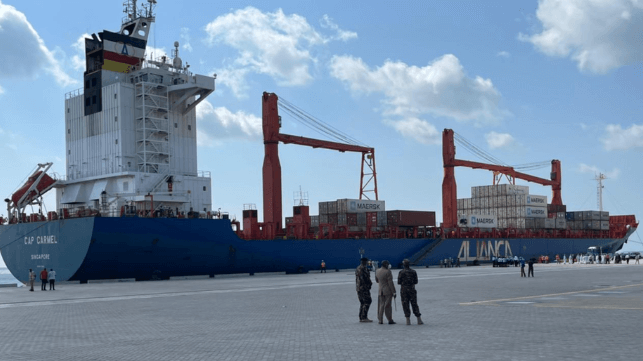New Security Risks Cast Shadow Over Kenya’s Struggling Lamu Port

Authorities in Kenya are having difficulty in encouraging shipping lines to use the newly-built Lamu Port as rising security risks threaten the viability of the facility, which has struggled to attract business after the completion of its first phase.
The coastal region of Lamu has in recent days witnessed a surge in deadly attacks believed to be waged by the terrorist group al-Shabaab, prompting the government to impose a 30-day dusk-to-dawn curfew.
The attacks have left 13 people dead, including four police officers who were killed after their vehicle was hit by an explosion. The violence is casting a dark shadow over Lamu Port, despite assurances by the government that insecurity will not affect the viability of the facility.
“The government has put in place all measures to secure Lamu. The massive security operation underway should not scare away investors or affect trade through the new Lamu port,” said Karanja Kibicho, Interior Principal Secretary.
The Kenyan government is undertaking a security operation to flush out militants behind the attacks and restore normalcy in the volatile area.
Security risks are the latest threat to the viability of the Lamu port, a facility that shipping lines have given a wide berth - and which risks becoming a white elephant, experts warn. Since its commissioning in May last year as a transshipment facility, the $367 million Lamu Port has only handled nine vessels and a total of 1,619 TEU.
The port has been using its first berth, which has a yard capacity of 17,000 TEU, and Kenya Ports Authority (KPA) has completed construction of berths two and three. KPA says it is in the process of acquiring modern equipment, including three mobile harbour cranes and ship to shore gantry cranes in order to complement operations at the port.
“The demand for global transshipment is there and our focus as KPA is to ensure that we continue to bring in modern equipment that will aid in enhancing turnaround time of cargo handling at the Lamu Port,” said John Mwangemi, KPA acting managing director.
Though the port, which was developed by China Communication Construction Company, is struggling to attract shipping lines despite incentives, the government intends to float tenders seeking for private companies to construct 20 more berths under a public-private partnership to complete the 23-berth facility.
Conceived in 2012, Lamu port was originally designed to be a massive $3 billion project that would be implemented over a 16-year period. It would have a total of 32 berths that would handle 24 million containers a year, effectively making it one of the biggest and busiest ports in the world.
Changing dynamics in the eastern Africa region - including port investments by neighboring countries like Somalia and waning interest by Ethiopia and South Sudan, the two countries that were supported to be the main source of transshipment business for the facility - have forced Kenyan authorities to rethink strategies for Lamu Port.
